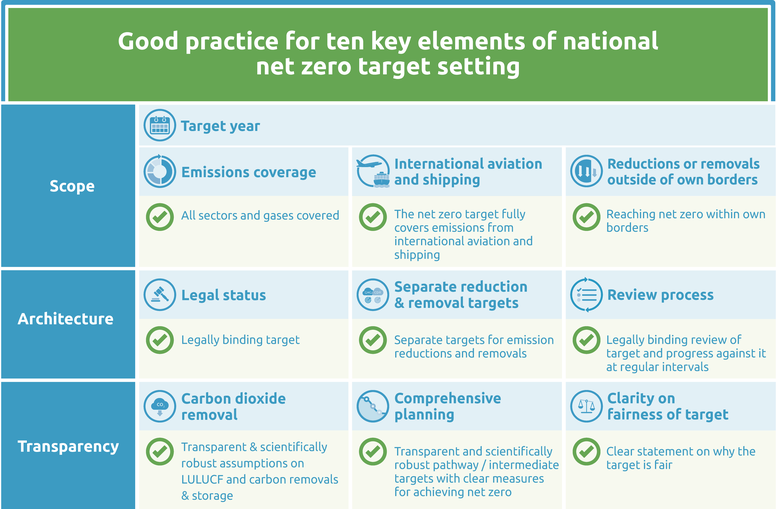Net zero targets
Summary
We evaluate the net zero target as: Poor.
The South Korean government included its commitment of carbon neutrality by 2050 in its updated NDC and Long-Term Strategy (LTS), which were both submitted to the UNFCCC in December (Republic of Korea, 2020a, 2020b). The carbon neutrality target is enshrined in law through the Climate Crisis Response Act, which was passed in August 2021.
South Korea’s target covers CO2 emissions, but not other GHGs. The government provides no information on the coverage of emissions from international aviation and shipping, and does not explicitly rule out the use of reductions or removals outside South Korea’s borders. Another shortcoming is the lack of detail in both the government’s review process and its plan to reach net zero CO2 emissions.
Ten key elements
Scope
- Target year – South Korea aims to reach net zero CO2 emissions by 2050.
- Emissions coverage – South Korea aims to achieve ‘carbon neutrality’ by 2050. This term is generally used to mean net zero CO2 emissions (IPCC, 2018). The government does not explicitly state that other GHGs are included in the target, although it lists reducing CH4 emissions in the waste sector through hygienic landfills and biological treatment facilities as a mitigation option. In the absence of a more explicit statement on the coverage of other GHGs, we assume that South Korea’s target covers CO2 only.
- International aviation and shipping – South Korea provide no information on its intention to cover international aviation and shipping.
- Reductions or removals outside of own borders – South Korea does not specify whether it will reach net zero CO2 emissions domestically by 2050. Two of the three draft pathways released by the Presidential Committee on Carbon Neutrality in August 2021, rely on the use of carbon offset credits from abroad (Hyeong-woo, 2021). The Committee will announce the final roadmap in October 2021 (Hyeong-woo, 2021).
Target architecture
- Legal status – The carbon neutrality target is included in South Korea’s LTS (Republic of Korea, 2020a) and has recently been enshrined in law through the recent Climate Crisis Response Act (Ministry of Environment, 2021).
- Separate reduction & removal targets – Although South Korea’s LTS gives a projection of the estimated carbon removal by forests until 2050, the government does not provide separate emissions reduction and removal targets. The Korea Forest Service announced a reforestation plan that could lead to a removal of 34 million tonnes CO2 (Republic of Korea, 2021). The plan, which aims to log and replant over 70% of South Korea’s mature forests, received a lot of criticism as it is based on a new definition of “old trees” and contested research on the lifetime carbon absorption of trees (Bang-Hyun and Kim, 2021; KFEM, 2021; Macdonald, 2021). Activists also comment that the estimate of 34 million tonnes CO2 removal is highly inflated (KFEM, 2021).
- Review process – In its LTS, South Korea states that it will regularly review and update its carbon neutral strategy (Republic of Korea, 2020a). The Climate Crisis Response Act states that sectoral strategies will be reviewed every five years and that the implementation of the strategy and targets will be assessed. However, the Act does not provide more specific information on this review process.
Transparency
- Carbon dioxide removal –The government does not present transparent assumptions on how it will achieve its intended CO2 removals until 2050 and has not yet identified concrete policies. South Korea describes the commercial deployment of CO2 removal amongst other future technologies as one of the five key elements of its 2050 vision (Republic of Korea, 2020a). The LTS also states that with existing policies, carbon sinks are likely to decline by 30% between 2015 and 2050, but the government “will continue its forest management to maintain the forest carbon removals at the highest level possible.” (Republic of Korea, 2020a). The Korea Forest Service’s plans to log and replant over 70% of the country’s mature forests are highly criticised by observers and activists, who claim the plans are based on invalid assumptions (Bang-Hyun and Kim, 2021; KFEM, 2021; Macdonald, 2021).
- Comprehensive planning – South Korea provides some general information on the anticipated pathway and measures across economic sectors that it will take to achieve carbon neutrality, but details are lacking. The government will develop scenarios for carbon neutrality by 2050, which take into account South Korea’s mitigation potential and level of technological advancements. Based on these scenarios, the government will establish implementation strategies and specific plans per sector (Republic of Korea, 2020a). South Korea’s updated NDC from December 2020 sets an interim target of cutting GHG emissions by 24.4% by 2030 below 2017 levels and states that the government will “seriously consider raising ambition level in its NDC before 2025” to better align the 2030 NDC target with the goal of net zero CO2 emissions by 2050 (Republic of Korea, 2020b). Overall, the strategy gives a thorough picture of the current situation and historical path as well as sector-specific 2050 visions but does not provide concrete measures. In August 2021, the Presidential Committee on Carbon Neutrality presented three draft pathways to reach net zero CO2 emissions (Hyeong-woo, 2021). The Committee will release the final carbon neutrality pathway in October 2021, after which we will update our assessment accordingly.
- Clarity on fairness of target – South Korea makes no reference to fairness or equity in the context of its carbon neutrality target.
Good practice
The Climate Action Tracker has defined the following good practice for all ten key elements of net zero targets. Countries can refer to this good practice to design or enhance their net zero targets.

Further analysis
Latest publications
Stay informed
Subscribe to our newsletter






